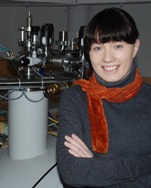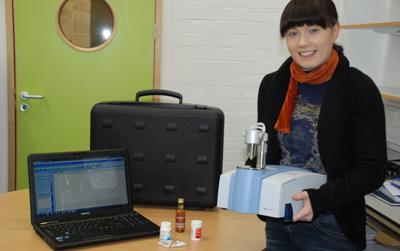A box of delights
How do we engage school children in science? Chemistry graduate, postgraduate research student and recent recipient of the Principal’s Medal, Nicholle Bell decided to start with the teachers.

Inspired by Dr Elizabeth Stevenson, programme director for the University’s MSc in Science Communication and Public Engagement, Nicholle Bell took every opportunity to better understand how to engage different audiences in science and technology as an undergraduate.
Supporting teachers
Nicholle noticed that there were engagement activities aimed at small children but what about the adults? A few of Nicholle’s university friends went into teaching and she heard first-hand about areas where they struggled to gain support. There was nothing to bridge the gap between the strengths and weaknesses of teachers.
I performed experiments for visitors at the University open days, demonstrated for school pupils at various science festivals across the UK, and even performed the synthesis of chloroform, while interviewed by Sir Ian Wilmut on BBC Radio Scotland.
As a postgraduate student and the recipient of a Principal’s Development Scholarship, Nicholle was able to tackle this issue head on when she was appointed as coordinator of Spectroscopy in a Suitcase (SIAS) Scotland and tasked with redeveloping the scheme for Scotland.
SIAS is a Royal Society of Chemistry outreach programme where teachers are trained to become comfortable with spectroscopy so they can teach students in exciting and interesting ways.

They do come in suitcases
Through SIAS Schools gain access to the miniature ATR FT-IR (Alphie) spectrometer and an UV-VIS spectrophotometer to help captivate pupils in modern analytical science.
With the equipment in the classroom students can become researchers. They make compounds, they find out what they have, if it is not there they can run another experiment, change a variable and then check again.
To engage children in science Nicholle strongly believes that this practical experience is essential.
The SIAS project is creating a new generation of chemists by for the first time bringing modern analytical techniques that we use on a day to day basis at a research level to the classroom.
What’s next?
Following the success of the SIAS, Nicholle hopes that the scheme can be extended to include Nuclear Magnetic Resonance (NMR) and mass spectrometry.
NMR is a topic close to Nicholle’s heart since it forms the base of her own research which uses NMR to look into the very complex mixtures of molecules that play a role in the various functions of soils.
NMR is also the natural next step since it is more powerful and more efficient than other analytical tools such as Infrared (IR) and Ultraviolet (UV), and the most widely used technique in analytical chemistry
Edinburgh University also have the best NMR facilities in the country and it represents an area in which teachers require support.
Alumni making the difference
A pilot scheme which goes by the snappy NMR4SHS (NMR for Scottish High Schools) acronym is already under way. It allows schools to gain access to the University’s NMR facilities by sending in samples for analysis.
NMR4SHS is available to schools in Scotland for free thanks to an alumni funded Innovation Initiative Grant.
Find out more
If you are interested in Nicolle’s work or know any chemistry teachers who would be interested in using SIAS or NMR4SHS then please contact her using the details below.

